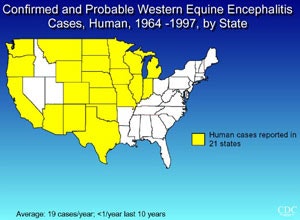Western Equine Encephalitis

We would like to acknowledge and thank the Centers for Disease Control for allowing
the use of the following information and links concerning mosquito-borne illness.
Challenges:
- No licensed vaccine for human use
- No effective therapeutic drug
- Unknown overwintering cycle
- Control measures expensive
- Limited financial support of surveillance and prevention
Trends:
- Epidemic disease that is difficult to predict
- Risk exposure increases as population expands into endemic areas
Surveillance:
- National Notifiable Diseases Surveillance System
Risk Groups:
- Residents of endemic areas and visitors
- Persons with outdoor work and recreational activities
Transmission:
- Mosquito Borne
Costs:
- Total case costs range from $21,000 for transiently infected individuals to $3 million for severely infected individuals
- Insecticide applications can cost as much as $1.4 million depending on the size of area treated
Sequelae:
- Mild to severe neurologic deficits in survivors.
Incidence:
- 639 confirmed cases in the U.S. since 1964.
Etiologic Agent:
- Western equine encephalitis virus, member of the family Togaviridae, genus Alphavirus. Closely related to eastern and Venezuelan equine encephalitis viruses
Clinical Features:
- Symptoms range from mild flu-like illness to frank encephalitis, coma and death.
